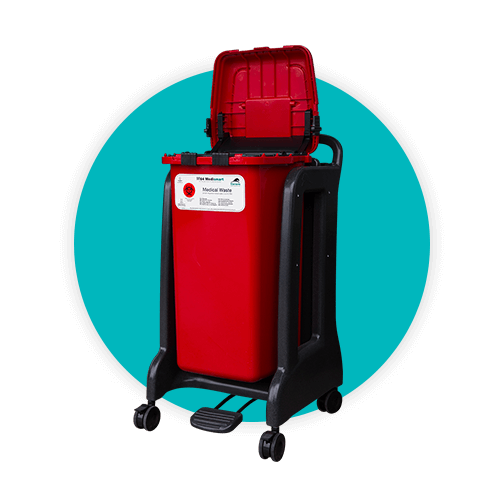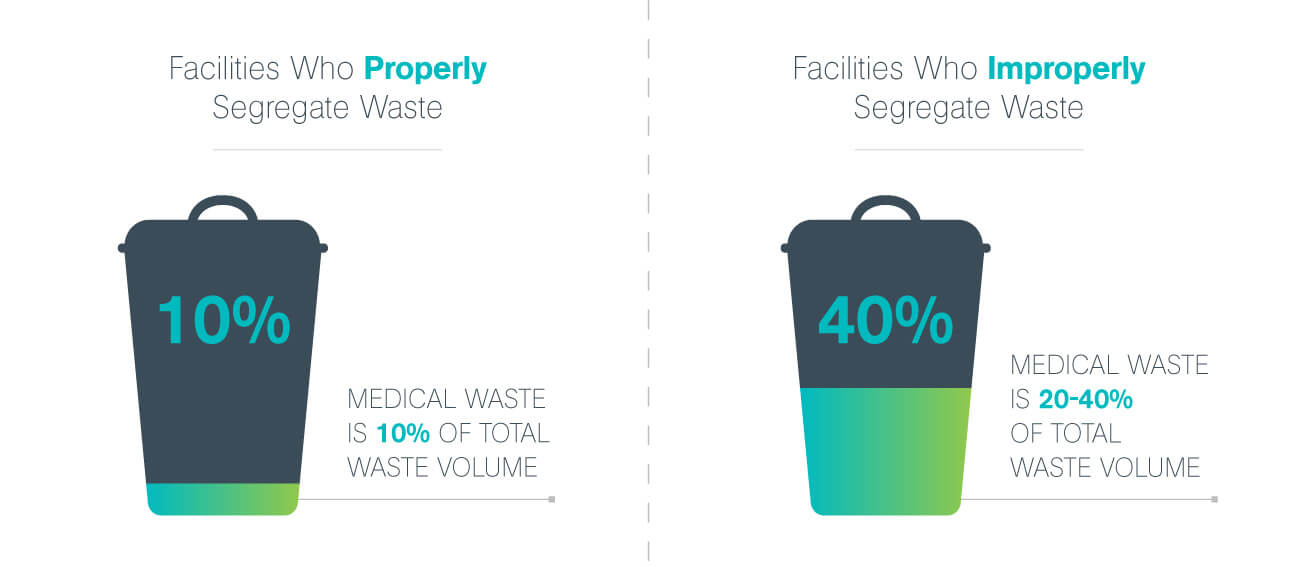How to Reduce your Total Cost of Medical Waste Management

7 Methods to Reduce Medical Waste Volume
If you’re like most healthcare professionals, you want to have cost-effective solutions whenever possible so that funds can be spent elsewhere – like patient care and staff. One area you can easily optimize at your facility is your medical waste volume generation output– which will, in turn, lower your total cost of ownership!
In this blog we will discuss the following strategies to reduce medical waste volume; you can click any section below to jump straight to it:
- Limit Access to Regulated Medical Waste Container
- Choose a container that’s clinically differentiated with a restricted opening
- Make it easy to segregate healthcare waste streams
- Go reusable! Eliminate excess plastic waste volume
- Eliminate Plastic Bags
- Educate, Educate, Educate!
- Implement a facility-wide recycling program
Implementing these small changes to your healthcare waste management program that will have a large effect on your total costs of medical waste disposal. Daniels Health has been serving the healthcare industry for over 35 years. In that time, we’ve learned that often the most impactful clinical, safety, and cost outcomes result from a few simple changes in process.
There are a number of key benchmarks that facilities are using to focus initiatives towards the reduction of medical waste volumes. Practice Greenhealth and ASHE have published benchmark studies for facilities to use as KPI’s to measure progress against, and as targets to aim for in terms of industry best practice. They update these benchmarks almost yearly making it a relevant resource for all healthcare waste management.
Before we jump in, what is Medical Waste?
It is important to fully understand the definition of Regulated Medical Waste as historical views on the medical waste definition differ substantially.
Regulated medical waste (RMW), also known as 'biohazardous' waste or 'infectious medical' waste, or even ‘red bag waste,’ is the portion of the waste stream that may be contaminated by blood, body fluids or other potentially infectious materials, thus posing a significant risk of transmitting infection.
Here are a few links to assist in more broadly understanding medical waste:
https://www.epa.gov/rcra/medical-waste
http://www.hercenter.org/rmw/osha-bps.php
01 / Limit access to Regulated Medical Waste containers.
A simple trick to improve waste segregation is to place RMW containers near the point of generation - the treatment site!
“If it’s accessible to all… it will be used by all” Ideally all RMW (regulated medical waste, biohaz) containers should be eliminated from patients’ rooms and visiting areas.
There are a variety of waste streams. Disposal and destruction costs vary by waste stream. For example, solid waste (pizza boxes, gum wrappers, the holiday bags you keep saving for some reason) will be disposed of and treated differently than Regulated Medical Waste. When situated in a public-access area your RMW containers run a high-risk of becoming incorrectly segregated. Incorrect waste segregation compounds the cost of disposing what would otherwise have been classified as non-regulated solid waste to a premium disposal rate of more than 70%.
To put it even more simply, an RMW container that contains only RMW is more cost-effective to dispose of and treat than an RMW container that holds regulated medical waste, coffee cups, and candy wrappers.
Daniels’ solution to point-of-use disposal in patient areas is its Medismart system; a hands-free pedal-operated containment system that can be wheeled in and out of the patient environment delivering compliant waste disposal without the risk and cost of unauthorized waste disposal. If Medismart containers are installed within the patient room, then the suggestion is to install them as close as possible to the waste-generation point, and away from regular waste containers to ensure compliant and best practice segregation.
02 / Choose a container that’s clinically differentiated with a restricted opening
A container (or cardboard box) with a wide opening that does not restrict visualization of contents, often contains much higher volumes of non-compliant waste because of a few key contributing factors.
- It’s easy! You don’t have to stop and make a conscious choice about whether the bin is intended for the purpose of the waste you’re about to deposit – it’s a big wide opening that’s waiting to be filled!
- Validation of other user mistakes “If I can see that there’s a soda can in there, then there’s no problem adding another one.”
- Domestic familiarity. If it’s the same bin (or familiar cardboard box) as the one you have at home, we’re already conditioned to equate it’s use to solid waste garbage. Just because it’s located in a clinical setting doesn’t register in the user’s mind that “it’s a clinical bin for clinical waste only”. You need a system that interrupts behavior.
Our Medismart system, for the reasons outlined above, has been proven to reduce medical waste volumes in hospitals by as much as 59%! It’s clinically designed for hands-free use (no cross contamination) with a lid that closes requiring conscious effort to be put into the process of medical waste disposal. Through multiple clinical studies and customer account stories we have successfully seen a reduction of large non-conforming items entering the medical waste stream, and an overall change in solid waste (low cost per pound) increase, and medical waste (high cost per pound) dramatically decrease.
03 / Make it easy to segregate waste
Let’s face it, we’re all human and when presented with only one choice (especially when we’re busy or attending to urgent patient needs), we won’t look around for the right alternative, we’ll just go with whatever is in front of us. One of the essential factors in optimized waste segregation is having the right bin in the right location so that the choice to segregate is made simple.
In a patient environment, make sure there is a bin for recycling and general waste accessible to staff. Make sure each bin is compliantly labeled and color-coded for instant recognition and placed in an accessible location to encourage best-practice-disposal.
04 / Go reusable! Eliminate excess plastic waste volume
33% of waste volume in the average medical waste container is the container plastic itself! Think lots and lots of single-use plastic sharps containers.
Imagine, you’re buying a single-use container and then on top of that purchase, you’re paying for the cost of disposing of the single-use plastic container within the high-cost pharmaceutical, chemotherapy or regulated medical waste stream. Financially and environmentally, disposable containers add significant cost to the process of healthcare waste management.
Quality lasts, and Daniels’ suite of clinically designed reusable containers stand the test of time. Our containment systems are designed with inbuilt locks and safety features that would be cost-prohibitive to design into a $20 throwaway container or cardboard box. By going reusable you get safer products for your staff and containers that are robotically washed and decontaminated after each use. By choosing reusable not only do you save your $20 by not having to buy a disposable single-use container, but you help divert plastic from going to landfill. Go green, the planet and your staff will thank you for it!
Not to mention, aren’t you tired of having to re-order single-use containers each month? Choosing a reusable solution with Daniels means one less thing for you to worry about. We estimate the right container count for our customer’s waste generation volume needs and provide empty containers that are exchanged with every service.
05 / Eliminate Plastic Bags
We’re all aware of the impact plastic bags have on the environment and the years (recent studies estimate between 10-1000 years) it takes for a bag to decompose in landfill, but what is not often spoke about is the cost. The rollout of Daniels Medismart system throughout a 580 bed hospital, resulted in a $40,000 annual cost saving through the elimination of bag purchasing! We realize that a small medical clinic with three full time staff is not going to achieve savings of this magnitude, but in all sized facilities you are able to consciously contribute to waste volume reductions through the elimination of plastic bags.
Daniels Medismart system is UN TDG certified as one the only medical waste container in the United States that does not require a plastic liner or secondary packaging (eliminating both bags and boxes!). Our robotic washing processes achieve a decontamination and bacterial load reduction that is the highest in the industry, and we divert more “waste” from landfill per container than any other system in the United States.
06 / Educate, Educate, Educate!
There are many misconceptions and misunderstandings about what can be classified as Regulated Medical Waste or ordinary solid waste; Waste Optimization can be a grey area. Staff members may take the over-classification approach and dispose of anything they’re not sure about as medical waste, this is an expensive practice for health care facilities which should be discouraged. Make sure your facility’s medical waste management plans are clearly defined and communicated.
It’s kind of like the story of Goldilocks’, there is a way to segregate your healthcare waste streams that is just right – and most cost-effective!
07 / Implement a facility-wide recycling program
Many Items in a medical facility are recyclable. Your facility should detail its recycling plan as part of the overall waste management plan and highlight key items for recycling. Education is the key for any recycling program along with proper placement of and signage for all recycling containers throughout the facility. Installing recycling as close as possible to the point of generation will also aid in a best practice recycling program.

It’s not hard to see that reducing medical waste volumes can have a real impact on the total cost of managing waste disposal at your facility.
The cost to dispose of medical waste is between 7-10 times greater than the cost of non-regulated solid waste disposal, and for the average healthcare facility medical waste should represent less than 10% of the total waste generated (The Centers for Disease Control puts this number at between 3-5%). Due to poor segregation practices, many US healthcare facilities are sitting between the 20% - 40% mark.
If you would like to speak to one of our experts on how to drive total cost reductions at your facility by changing your approach to medical waste management and waste segregation, reach out to us, we would love to walk you through some options.

